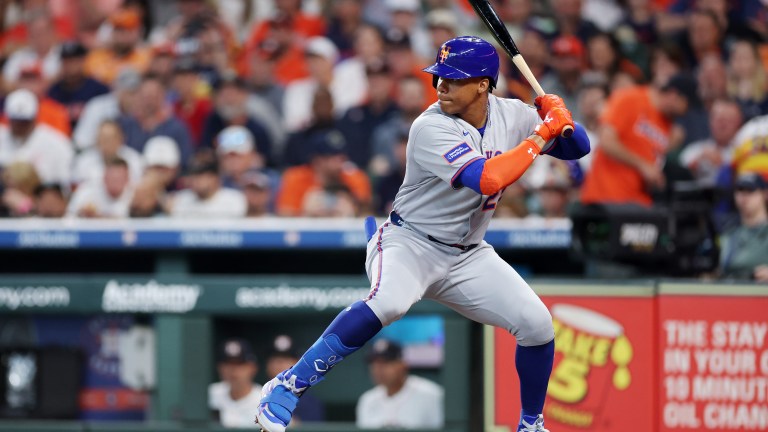It’s Only a Matter of Time Before Juan Soto Gets Hot
Despite his slow start, Juan Soto will (eventually) be just fine in his new home.

In 2025, only two players across baseball are in the 90th percentile in both hard-hit rate and chase rate: Kyle Schwarber and Juan Soto.
Schwarber ranks sixth in the league in wRC+ and is tied for the league lead in home runs. His OPS sits at .974, as he is leading a Phillies offense that is leading the National League East. In a walk year, Schwarber is putting up the type of season that will set him up for a sizeable paycheck in the offseason.
On the other hand, one scroll through any baseball social media site would have you believe that Soto is the next Jason Bay after signing a record contract with the New York Mets in December. Yet, he finds himself on an exclusive list, joined only by the league’s leading home run hitter.
After he inked a deal that could net him upwards of $800 million, the expectations for Soto are sky-high. However, he has hit just .236 while his slugging percentage has plummeted to .414 — a far cry from his .569 clip a year ago.
Fifty-two games into year one of a 15-year deal, should Mets fans be worried about Soto, or is he just undergoing the natural growing pains that plague many of the Mets’ big-fish acquisitions?
Juan Soto’s Return to Yankee Stadium
Soto recently experienced his first Subway Series from the Mets’ side of the rivalry. It didn’t go well.
Amidst constant booing from the Yankee faithful — as well as other antics from the Bleacher Creatures as they perched above him in right field — Soto went just 1-for-10 in the three-game set that saw the Mets drop two out of three. While he drew four walks, he also struck out three times.
During the third game of the series, Soto struck a soft line drive towards the middle that forced Yankees second baseman DJ LeMahieu to make a sliding stop. Despite the difficult nature of the play, Soto did not appear to bust hard out of the box in a tie game as LeMahieu retired him at first base.
Throughout the week leading up to the series, Soto’s confidence appeared to be at an all-time high. In interviews, he consistently spoke of his excitement for the series, while manager Carlos Mendoza lauded Soto’s ability to block out outside noise. Even after giving a curtain call during his first at-bat — which was of course met with boos — Soto never appeared comfortable in his return to the Bronx.
Hustle Questions
After the Mets went on to lose their Sunday night tilt with the Yankees, Soto’s lack of hustle appeared to carry over into the next night.
In the Mets’ series opener in Boston, Soto launched a fly ball towards the Green Monster in left field. After briefly watching it, expecting that it would go over the fence, he realized that it did not have the distance and was forced to settle for a long single, which furthered the concerns about his hustling, or rather lack thereof. Granted, Soto immediately made up for not getting a double on a ball off the fence, as he stole second during the next at-bat.
At the time of writing, Soto has stolen five bases in his last 10 games, an extremely high rate of steals for someone who ranks in the 17th percentile in sprint speed.
Truthfully, Soto is not known as a burner and has never been someone who routinely turns singles into doubles. Mets owner Steve Cohen made him the highest-paid athlete for his ability to mash, not to be a scrappy base thief.
What is really eye-opening is the perceived lack of confidence, as the “Soto-Shuffle” has disappeared this season.
Encouraging Batted Ball Data
Soto’s calling card is his bat, which has not lived up to its billing this season. Yet, one could argue he has been the most unlucky hitter in baseball. Just look at how hard he’s been hitting the ball:

Even amidst a slow start, Soto is still an on-base machine. His 40 walks are tied for third in MLB. Moreover, his Baseball Savant page still shows up mostly red, similar to prior years when he was among the best hitters in the game.
Soto’s .300 xBA puts him among the top 20 qualified hitters. Yet, his actual .236 batting average is 112th leaguewide. That discrepancy is the eighth-largest difference between expected batting average and actual batting average in either direction, at a whopping 64 points.
As previously mentioned, Soto’s hard-hit rate is still elite, sitting in the 96th percentile.
Interestingly, Soto is going out of the strike zone less and swinging and missing on fewer pitches than in last year’s campaign, which garnered him MVP consideration. His chase rate has dropped from 18.3% to 15.1%, while his whiff rate has gone from 21.5% down to 19.5%.
Aside from hitting into hard luck, there are a few areas of improvement that Soto can control. For starters, his bat speed has gone down. Additionally, he is pounding balls into the ground significantly more often than he did last season.
Over the past year, Soto’s bat speed has gone from the 94th percentile to the 71st percentile. In 2025, he is simply taking more ugly swings compared to previous years. While he put up a bat speed of at least 75 mph on nearly 60% of swings in 2024, that number is down to 38.1% in 2025. He is also in a tie for the fourth-most swords in the game, essentially showing a lot of non-competitive hacks.
Meanwhile, his groundball rate (per Statcast) has jumped from 44.7% to 52.9%. His launch angle sweet-spot percentage — which historically has never been terribly high — has dropped from the 65th percentile to the 17th percentile.
To put it simply, Soto is still hitting the ball extremely hard, but he isn’t hitting the ball at ideal angles, which is causing a rise in ground balls.
Takeaways from Soto’s First Months with the Mets

In the long run, Juan Soto will be just fine. At just 26 years old, he has already put together seven years of stellar play. After all, he is still managing a .777 OPS and a 121 wRC+ in 2025, so it isn’t even like he has been a bad hitter. He has just yet to find the same success with the Mets as he did in his prior three homes.
52 games should not scare Mets fans into thinking that Soto’s contract is already a bust. While his rising groundball rate is something to keep an eye on, Soto is too smart a hitter to let the struggles persist.
Patience will be the key, as it is only a matter of time before the hits start falling, the confidence returns and Soto becomes the force that the Mets thought they were getting in the offseason.
